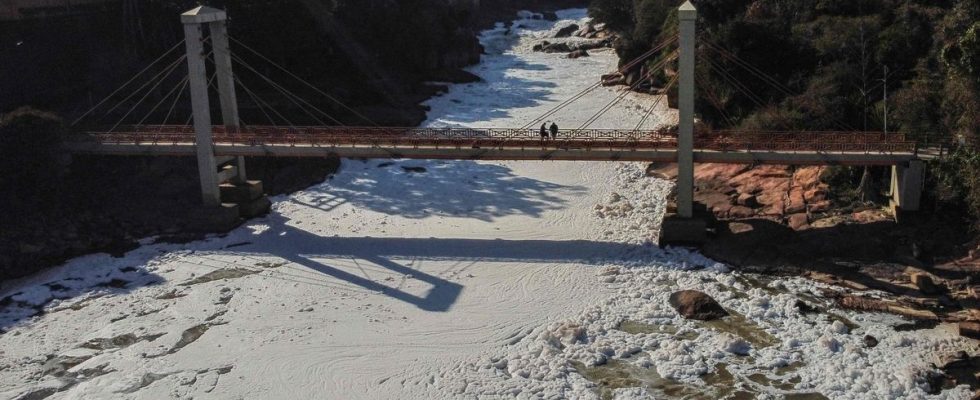As stopped in time. In the Brazilian tropics, a stream appears covered in a layer of freshly fallen snow. But it is in fact a toxic foam that dyes the Tietê river white, polluted by residues of detergents and other cleaning products. An impressive image, 100 km from Sao Paulo (southeast), the largest megalopolis in Latin America.
A tributary of the Parana River, the Tietê River, which extends over 1,100 km, is fundamental for the supply of drinking water, the irrigation of agricultural land and the production of energy in the most populated region of Brazil. The foam, visible since the end of last week, is the visible face of the pollution caused by phosphate and phosphorus from cleaning products discharged into the sewers of the Sao Paulo agglomeration (22 million inhabitants).
“When these residues enter the strong current of the Tietê, it’s like turning on a washing machine,” Malu Ribeiro, head of public policy issues at the NGO SOS Mata Atlântica, told AFP. The toxic foam, which at one point spread over more than 10 km of the river, was mainly observed in the vicinity of Salto, a city of 140,000 inhabitants. It is particularly present in the many waterfalls of the region.
“Acid Rain”
The foam releases a strong smell, with the risk of causing sore throats and respiratory problems. And any contact with polluted water can cause skin problems. Not to mention the consequences for fish and local fauna, comparable to “acid rain”, according to Malu Ribeiro. This phenomenon is recurrent during the dry months of the austral winter, when the flow of the river is reduced by half, which prevents the more concentrated chemicals from dispersing.
In the 1990s, the situation was even more critical: the foam sometimes broke into the streets of the towns located on the shore. The improvement of the water treatment network has made it possible to attenuate the phenomenon in recent years. But the massive appearance of this foam last week is due “to a drastic change in the temperature of the water”, deplores the SOS specialist Mata Atlântica. In the region, the temperature contrast can be significant in winter, with very cold mornings and very hot weather later in the day.
“Cold water is heavier, and it drags polluting residues to the bottom (…) But when it is heated by the sun, these residues rise to the surface and form a thicker foam”, describes Malu Ribeiro. One of the solutions would be to push back the vegetation on the banks, so that the stream is more shaded. But SOS Mata Atlântica recommends above all a total ban on phosphate and phosphorus in cleaning products.
And water treatment remains a major problem: in the Alto Tietê basin, which includes the Sao Paulo agglomeration, 86% of wastewater goes into the sewer, but only 54% of it is treated, according to official figures dating from 2021. The local authorities promise to act, with in particular “5.6 billion reais (about 1.05 billion euros) of investments in the water treatment network by 2026”, says the Secretariat of Environment and Infrastructure of the State of Sao Paulo in a press release.

